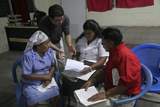Over the years, I have heard Ron Bueno, ENLACE’s Executive Director, explain to our staff, local church partners and donors why he believes that the church is the answer to poverty in El Salvador. I asked him recently to write down his answers to the most frequently asked questions regarding ENLACE’s commitment to equip local churches to transform their communities. I've asked Ron to address the following questions:
· Why the church?
· What is the church’s mission?
· What is community transformation?
· What impedes more churches from transforming their communities?
· How would you describe a church that is transforming their community?
Over the next few weeks we'll post Ron's responses to these core questions. Thank you for taking the time to read these posts and we appreciate your comments.
-David McGee
Director of Communications
QUESTION 1: WHY THE CHURCH? by ron bueno
From the beginning of ENLACE in 1993, I believed that we had to encourage and equip local community leaders to develop
their own solutions to poverty. I realized that it was vital for local leaders to identify and build upon available resources and experiences in order to design and manage initiatives that would have a long-term impact in their communities. At first, we focused our training and coaching on community and church leaders, but we soon realized that the church was the best agent of change in their own community for three reasons: 
church training in las delicias
- Only an intimate relationship with Jesus Christ can change people’s hearts to create a viable community and therefore community development . In the first few years, we worked hard to include the community in the design and management of projects so that they would have ownership and participation; however, we realized that no matter how well we helped the community design their projects to be just and efficient we could not change people’s relationships to each other. For example, people would work together to build a water system they all needed, but as soon as there was a problem with someone’s spigot, they would not necessarily work together to help that person resolve their problem. The project could not restore relationships, which is the first and most important step in community transformation; only an ongoing, dynamic relationship with Jesus Christ can truly change someone’s heart to think of others before themselves.
- It is the church’s mission to restore people unto God and to each other. Community leaders and associations with whom we first worked, ultimately had their own interests in mind and so were influenced by quick solutions or political forces. Additionally, there was a high rate of turnover among community association leaders due to political, personal, and financial reasons (including migrating to the U.S. for work). In contrast, the church’s leadership, seen as body and not as individuals, was a continuous and steady presence in the community which did not act, at least when done well, upon political or personal interest. Rather, the church body committed to a long-term process because it believed in a biblical mandate that led them to commit to their communities.
- The church is a continuous reservoir of resources. ENLACE has worked primarily with churches of less than 100 members located in impoverished, rural areas of El Salvador. Many of the church leaders believed they did not have the financial or human resources to become effective agents of change in their community. As soon as they looked at their church more closely and began to partner with their community, they discovered a wealth of skills and resources within their congregations. Churches already had, or could develop quickly, great fundraising skills and could pool resources together effectively. They also had a deep commitment to stewardship and compassion which made them an endless reservoir of resources to transform their communities.
Please continue to check back over the next few weeks as we continue with these questions.


